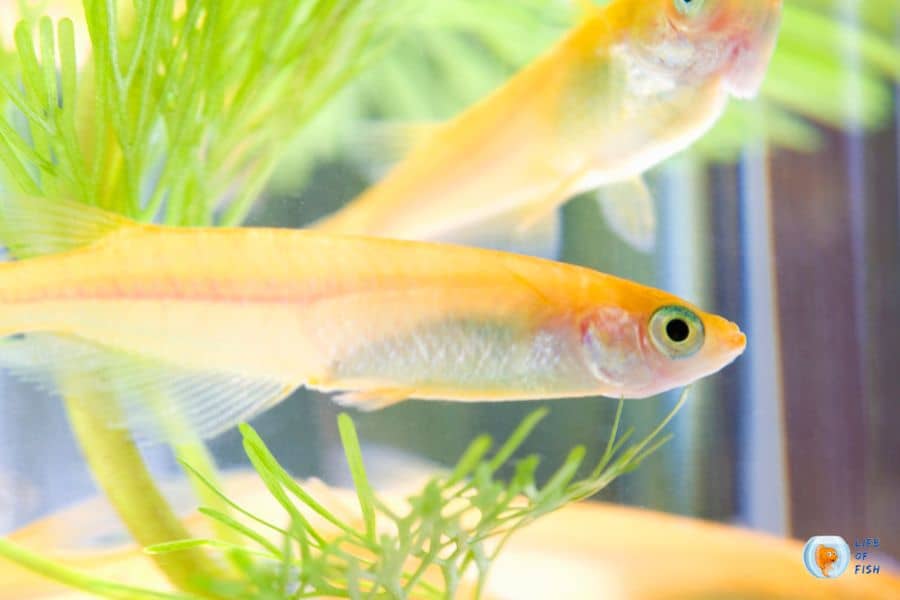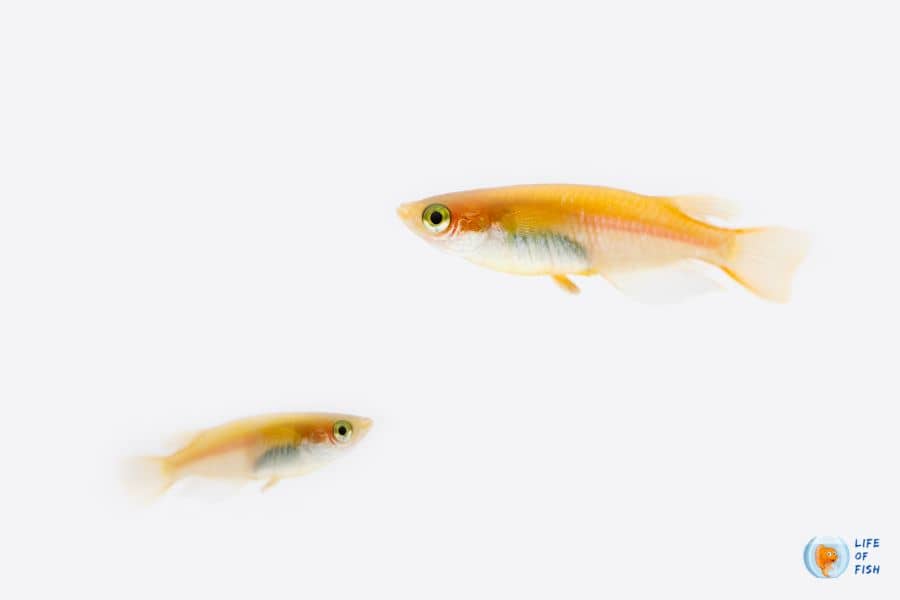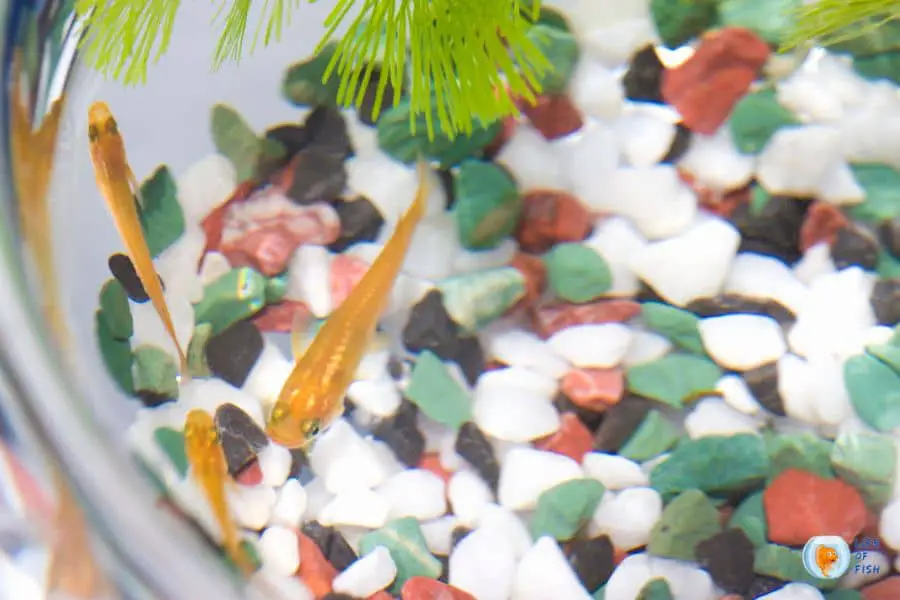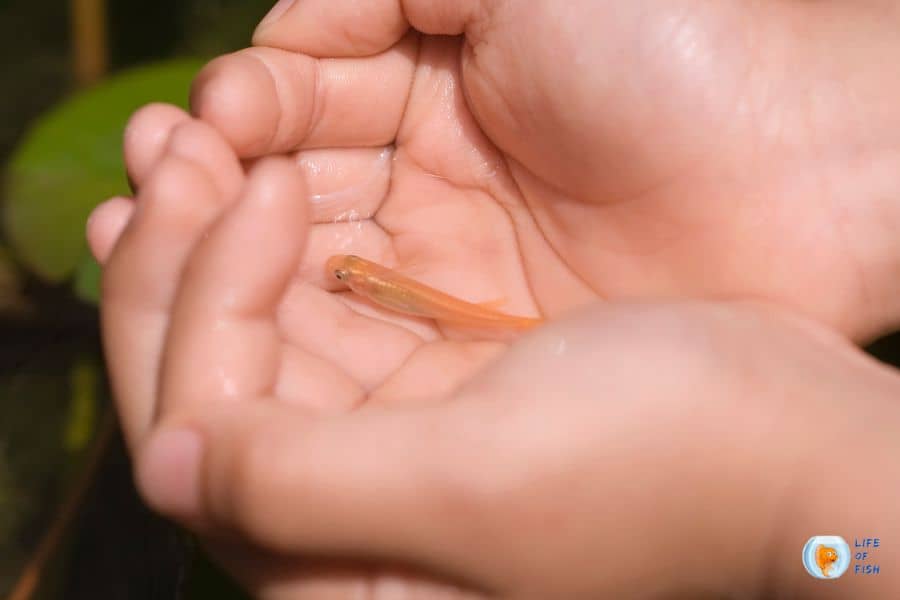I love Japanese rice fish because of a special reason. This species of fish went to outer space !! They’ve been sent into outer space as a part of a reproductive experiment because they’re among the easiest to breed fish in captivity. They’re also attractive, schooling fish that make great additions to many community aquariums.
Although they are excellent beginner-friendly fish, they need special environmental conditions to thrive. This article will teach you everything you want to know about taking care of Japanese rice fish.

What Is Japanese Rice Fish?
Jump To
- 1 What Is Japanese Rice Fish?
- 2 One Look Care Guide
- 3 How Big Do Japanese Rice Fish Get?
- 4 Japanese Rice Fish Lifespan
- 5 Is Japanese Rice Fish Aggressive?
- 6 Japanese Rice Fish Behavior
- 7 Japanese Rice Fish Care
- 8 Japanese Rice Fish Breeding
- 9 How To Feed Japanese Rice Fish?
- 10 What Fish Can Live With Japanese Rice Fish?
- 11 Summary
The Japanese rice fish (Oryzias latipes), also known as Medaka or Japanese killifish, is a small freshwater fish native to East Asia. It is a member of the Oryziidae family, which contains 21 other species of fish. They are the only member of this family that is found outside of East Asia.
The history of Japanese rice fish goes back to the 17th century when the Japanese people began to domesticate them. Japanese rice fish were originally found in the paddy fields of Japan. Their semi-transparent and glow-in-the-dark nature made them popular among aquarists.
They are small fish that can be found in a variety of colors, including white, yellow, orange, and red. This fish is a euryhaline fish, meaning it can live in fresh and saltwater environments. They are, however, most commonly found in freshwater. The Japanese rice fish is a schooling fish, which means that they live in groups. You can find these fish in paddy fields, ponds, and streams in the wild.
One Look Care Guide
| Scientific name | Oryzias latipes |
| Common name | Japanese rice fish, Medaka or Japanese killifish |
| Care level | Easy |
| Native to | East Asia |
| Type | Euryhaline fish (Freshwater and brackish water fish) |
| Color | White, yellow, orange, and red |
| Tank size | 10 gallons |
| Preferred temperature | 76-82 degrees Fahrenheit (24.4-27.7 degrees Celsius) |
| Other water parameters | Ammonia: 0.02 ppm Nitrite: 0.01 ppm Water hardness: 5-25 dKHPH level: 7-8 |
| Preferred salinity | 1.005-1.010 |
| Size | 1.5 inches (3.8 cm) |
| Life Span | Up to 5 years in captivity |
| Temperament | Peaceful |
| Recommended tank mates | Similar sized peaceful fish |
| Preferred food | Omnivorous, flakes, pellets, fresh, frozen and freeze-dried food, vegetables |
| Feeding frequency | 2 times per day |
| Breeding | Easy, egg layers |
How Big Do Japanese Rice Fish Get?
The maximum size of this fish is about 1.5 inches (3.8 cm). However, most Japanese rice fish only grow to be about 1 inch (2.54 cm) long. They are excellent for small-sized aquariums.
Japanese Rice Fish Lifespan
Their lifespan is about 2-3 years. However, if these fish are well cared for, they can live up to 5 years. Usually, captive-bred fish have a longer lifespan than wild-caught fish.
Is Japanese Rice Fish Aggressive?
No, they are not aggressive fish. In fact, they are one of the most peaceful fish you can keep in your aquarium. However, they tend to seclude themselves from other fish and prefer to school with their own species.
Japanese Rice Fish Behavior
They are is peaceful and shy. In the wild, Japanese rice fish can be found in groups of up to 100 fish. They are schooling fish and prefer to be in the company of their own species. You should keep Japanese rice fish in groups of at least six fish in the aquarium. They may become stressed and fail to thrive if kept in smaller groups.
They are shy fish and may be intimidated by larger and more aggressive fish. Therefore, you should keep them with peaceful fish that are similar in size.

Japanese Rice Fish Care
Caring for them is quite easy if you know how to set up their habitat and give ideal tank conditions.
Japanese Rice Fish Size
As we’ve mentioned before, Japanese rice fish are small fish. They only grow to be about 1-1.5 inches (2.54-3.8 cm) long. Therefore, you don’t need a large aquarium to keep them.
Japanese Rice Fish Tank Size
Although this is a very small fish, it needs to live in groups. Therefore, you’ll have to provide at least 10 gallons (37.8 L) of water per small fish school—however, the more, the better.
How Many Fish Should Be Kept Together?
Since these fish are schooling fish, they should be kept in groups of at least six fish. You’ll need a bigger aquarium if you want to keep a larger school. It’s best to keep them in even numbers so that they can school evenly.
Tank Setup
If you have experience in caring for betta fish, then setting up the tank for Japanese rice fish would be easier as both species have very similar needs.
First, you’ll need to fill your aquarium with clean fresh water. Since these fish are used to living in paddy fields with shallow, clean water, you will have to provide the same conditions in their aquarium. You can use a water conditioner to remove any harmful chemicals from the water. Better yet, use filtered or distilled water to fill up your tank.
Substrate
The wild habitats of these fish contain muddy substrate, but you may not appreciate a muddy-looking aquarium in your home. Therefore, you can use a variety of substrates such as gravel, sand, or even bare-bottom tanks. Just make sure that the substrate you choose is not too large as these fish are small and may accidentally ingest them. Since these fish are top-dwelling fish, the substrate is not as important as it is for some other fish species.
Filtration
Because these fish are sensitive to water conditions, a good filtration system is essential in your aquarium. A good filtration system will help to keep the water clean and free of harmful toxins. You can use a hang-on back or internal filter for your aquarium. Just make sure that the flow rate is not too strong as these fish are not strong swimmers.
Aquarium Decor
Since these fish are shy and timid, it’s important to provide plenty of hiding places in their aquarium. You can use live plants, rocks, driftwood, or even ceramic caves. Make sure that there are no sharp edges on the decor that could harm these delicate fish. You can also use a floating plant cover to help reduce the amount of light that enters the aquarium. This will help to make these fish feel more at ease.
Tip: We highly recommend live plants such as anacharis, hornwort, or dwarf Sagittaria. They not only provide places for these fish to hide, but they also help to keep the water clean and free of toxins.
Lighting
Japanese rice fish are used to living in shady and murky waters. Therefore, you don’t need to provide strong lighting in their aquarium. In fact, too much light can be detrimental to these fish. You can use a low-wattage fluorescent bulb to provide some lighting in the aquarium. This will help to show off the natural colors of these fish.
Tank Lid
Japanese rice fish have very good mobility and can jump out of the aquarium quite easily. Therefore, you’ll need to have a tight-fitting lid on your aquarium to prevent them from escaping. You can simply use a sponge lid, as it will still allow some air to circulate in the aquarium. If you use an airtight lid, make sure to drill some holes in it to allow for proper ventilation.
Water Temperature
These fish are tropical fish and prefer warm water. The ideal water temperature for these fish is 76-82 degrees Fahrenheit (24.4-27.7 degrees Celsius). You can avoid using a heater in their aquarium if you live in a warm climate. If you live in a colder area, you’ll need to use a heater to keep the water at the proper temperature.
Water Quality Condition
As we mentioned before, these fish are very sensitive to water conditions. Therefore, it’s important to do regular water changes and to keep the water clean. You should do a partial water change of about 20-30% every week.
Japanese rice fish are also very sensitive to ammonia and nitrites. Therefore, you’ll need to have a good filtration system in your aquarium. A good filtration system will help to keep the water clean and free of harmful toxins.
The tolerable ammonia level for these fish is 0.02 ppm. The tolerable nitrite level is 0.01 ppm. You can use an ammonia and nitrite test kit to test the levels of ammonia and nitrites in your aquarium. The water hardness for these fish should be in the range of 5-25 dKH. The pH level for these fish should be in the range of 7-8. If these fish are acclimated to brackish water conditions, then the salinity should be in the range of 1.005-1.010sg.

Japanese Rice Fish Breeding
They are very easy to breed because they reproduce on a daily basis. However, you should avoid introducing other fish species into the breeding tank because they eat the eggs and fry.
Japanese Rice Fish Male Or Female Identification
There are some variances between male and female Japanese rice fish, but they are subtle. The female has a smaller triangular-shaped fin, while in the male, the fins are longer that almost touch the tail. The female fish has a more swollen and rounded belly, giving them a more pear-shaped appearance. The male fish is much slimmer in comparison to the female and has a long and pointy belly. Other than these differences, the males and females look very similar to each other.
Identify Pregnant Japanese Rice Fish
Because rice fish are egg layers, they don’t go through a pregnancy stage like many other animals. Instead, mating occurs frequently for several months before the fish take a break for a few months. This process then repeats itself.
After fertilizing the eggs, they spend several days developing inside the female. Each day, she lays up to 20 early in the morning. They have thin filaments that keep them clustered near her vent for a few hours; it looks as if she’s swimming with a cluster of grapes attached.
The eggs fall to the bottom or attach to the plants as she swims through fine-leaved plants. She gives no further care to the developing embryos from then on. The Japanese rice fish eggs hatch in a few days to two weeks after being placed on the plants.
Japanese Rice Fish Breeding
To breed these fish, you’ll need a breeding tank of at least 10 gallons in size. The water parameters in the Japanese rice fish breeding tank should be comparable to those in their natural habitat. You’ll also need to have a lot of plants in the breeding tank. The plants will serve as a place for the female to lay her eggs.
The breeding tank should also have a layer of fine gravel on the bottom. A bare bottom will also work if you remove the parents after spawning. If you feed the parents well, you may not need to remove the parents as well. However, some juvenile rice fish may prey upon the eggs and small fry. In this case, you may want to separate fish fry with a more than a week difference in age.
When the female rice fish is ready to lay her eggs, she will release them into the plants. The male will then fertilize the eggs. After fertilizing the eggs, they will hatch in about a week or two. The Japanese rice fish fry will be very small and will need to be fed micro food such as baby brine shrimp, nauplii, or micro worms.
How Many Babies Do Japanese Rice Fish Have?
A female fish can lay up to 20 eggs per day. However, not all of the eggs will be fertilized by the male. However, you can expect around 100 fish fries in one season.
Do Japanese Rice Fish Eat Their Babies?
Japanese rice fish are not known to eat their babies. However, other fish species may eat the eggs and fry. This is why it’s important to have a lot of plants in the breeding tank. The plants will serve as hideouts for the fry. You may also want to remove the parents after spawning to prevent them from eating the fry.
Japanese Rice Fish Fry Care
Japanese rice fish have a rapid growth rate. They can grow up to 1 inch per month. Their growth rate, however, will slow as they reach adulthood. By the end of their first week after hatching, they will be able to eat newly hatched brine shrimp. You can also offer them micro worms and finely ground flake food. You can offer them larger food such as daphnia, bloodworms, and tubifex worms as they grow.
Special Tips
- If you’re having trouble finding suitable food for your fish fry, keep daphnia in your breeding tank. As they reproduce, your fry will have enough nauplii to supplement your fries’ needs.
- To prevent your fry from getting lost in the plants, you can use a turkey baster to gently suck them up and place them in a separate tank.

How To Feed Japanese Rice Fish?
Japanese rice fish are omnivores. In the wild, Japanese rice fish eat a variety of small insects, crustaceans, and plant matter. In captivity, you can feed them a variety of live, frozen, and dried foods. Brine shrimp, daphnia, bloodworms, and micro worms are all excellent live foods. Frozen foods such as mysis shrimp, krill, and bloodworms can also be fed to them.
Dried foods such as flakes, pellets, and granules are also suitable. To ensure a well-rounded diet, provide a variety of foods. How often you feed your fish will depend on their age and size. You should feed juvenile fish 2-3 times a day. You can feed adult fish once or twice a day. Overfeeding your fish can lead to problems such as obesity and poor water quality. Therefore, it’s essential only to offer as much food as your fish can eat in a few minutes.
What Fish Can Live With Japanese Rice Fish?
Japanese rice fish can live with a variety of peaceful fish species. Good tank mates include guppies, platies, mollies, swordtails, and tetras. You can also keep them with other rice fish, such as the golden or silver varieties. Avoid keeping them with aggressive fish species such as cichlids and bettas. These fish may bully or harass the rice fish.
Also, avoid keeping these fish with larger fish species. The rice fish may become lunch for their tank mates. When selecting tank mates, be sure to choose fish that require similar water conditions. Japanese rice fish prefer neutral to slightly acidic water with a temperature around 75-82 degrees Fahrenheit.
Summary
Japanese rice fish are easy to care for as long as you provide them with a suitable habitat. They prefer to live in groups and do their best in planted tanks. Be sure to offer a variety of foods to ensure a well-rounded diet. Avoid keeping them with aggressive fish species. When selecting tank mates, be sure to choose fish that require similar water conditions.
Read Next: Mysterious Hairy Shrimp : Facts Reveled
